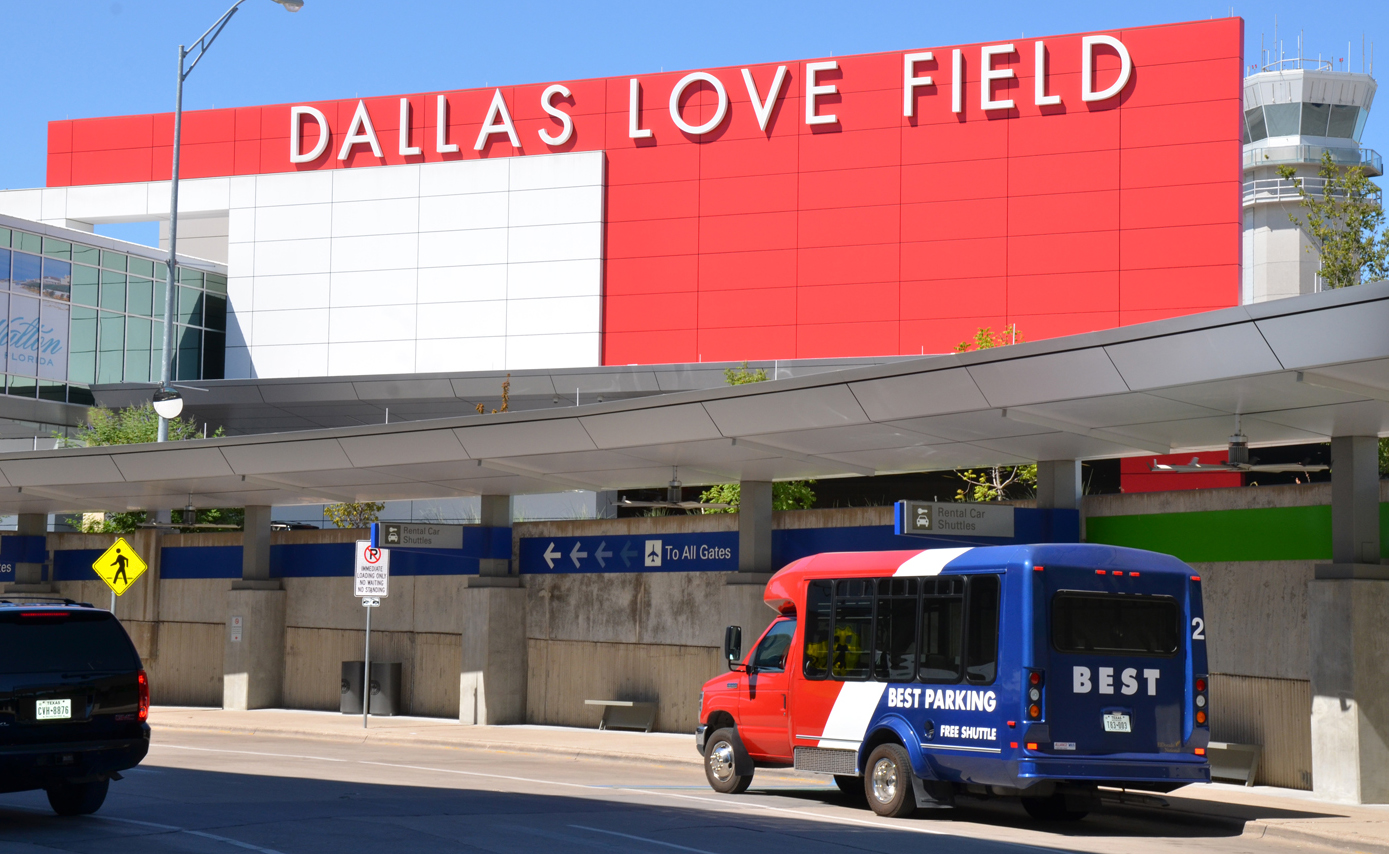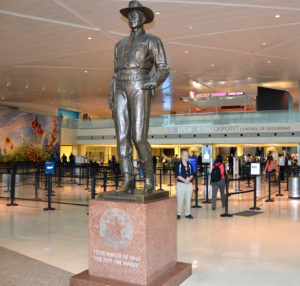
Love Field expansion increases options, Spurs investment without raising taxes. Photo by David DeVoss
By David DeVoss
For the past 35 years whenever a resident of Dallas, Texas wanted to fly to New York, Chicago or Los Angeles he had to drive half way to Ft. Worth to depart from Dallas-Ft. Worth Airport. This year that same traveler can fly to every major city in the continental U.S. out of Love Field, a smaller more efficient facility just minutes from downtown.
Dallas’ 1.3 million people owe their good fortune to the demise of the Wright Amendment, an onerous modification of the 1978 Airline Deregulation Act that for the past 35 years has restricted the number and destinations of flights in and out of the city’s in-town airport.
The main beneficiary of the Wright Amendment’s demise is Southwest Airlines. It has spent the past decade fighting for the right to fly nonstop from its home base in Dallas to major U.S. cities outside Texas. “Southwest President and CEO Gary Kelly says the liberation of Love Field will allow nonstop flights to 93 destinations. “Forty percent of our passengers already are flying for business,” he says. “Now that we’re a true transcon airline we can grow rapidly. Low fares, no baggage fees and inflight Wi-Fi are even more appealing when they are offered on nonstop, cross-country flights.”
Consumers from all parts of the country who fly through Dallas already are benefitting from lower ticket prices. Months ago Southwest began celebrating the Wright Amendment’s demise with a limited time offer $99 fare between Dallas and 15 cities. Virgin America, which operates two of Love Field’s 20 gates, immediately matched the offer by selling Main Cabin select and First Class seats at a 50% discount. Both companies plan to keep fares low.
American Airlines was forced to relinquish its two Love Field gates when it merged with US Airways, but it remains competitive with lower fares on similar routes out of D/FW airport. For most of the summer American was charging more than $400 for nonstop service between D/FW and Washington Reagan. Starting October 13, it will sell the same round trip ticket for as low as $175. In the past, American flights between New York LaGuardia and D/FW were $400 or higher. Now they sell for around $250 for travel starting October 13 and beyond.
Promotional fares don’t last for long but many analysts believe ticket prices will remain low for the foreseeable future. With only 15 miles separating the two airports, proximity alone will keep prices competitive.
Getting politics out of commercial aviation seems logical today, but back in 1964 there was no serious objection when Washington officials told Dallas and Ft. Worth to close their individual airfields and agree on a site for a regional airport. They selected 17,000 acres of vacant prairie midway between the two cities and convinced Braniff, American and Texas International to move their operations to the new Dallas/Fort Worth International Airport when it opened in 1974. Southwest, an intrastate carrier started in 1971, was not party to the original agreement. It refused to leave Love Field and successfully fought eviction in court.
Southwest’s legal victory put the viability of DFW in question. Prior to the opening of DFW, Love Field served 6.6 million passengers a year making it the tenth busiest airport in the world. Seventy-five percent of the departing passengers were from Dallas. Why would anybody drive halfway to Ft. Worth if they could catch a flight to the same location out of Love Field?
To save their investment, Dallas, Ft. Worth and the airlines that had moved to D/FW jointly petitioned Ft. Worth congressman James Wright to support a law that decreed that Love Field flights in large aircraft with more than 56 seats could fly nonstop only to cities within Texas or the four surrounding states of New Mexico, Oklahoma, Arkansas and Louisiana. Passengers bound for Los Angeles, for example, would have to change planes in El Paso or Albuquerque before traveling onward. Driving to DFW didn’t seem so bad if the alternative was purchasing two tickets and spending more than an hour changing planes.
One entrepreneur tried to get around the restrictions. In the spring of 2000, former Federal Express executive T Allan McArtor started Legend Airlines with DC-9s that used Love Field as a hub to fly nonstop to Las Vegas, Los Angeles, New York and Washington Dulles. Because each plane contained only 56 business class seats, the Wright Amendment did not apply. American Airlines, which controlled two gates at the airport, reconfigured a number of Fokker 100 jets to 56 seats and began under-selling Legend. By the end of the year the upstart luxury carrier filed for Chapter 11.

Bruce Bleakley at Frontiers of Flight Museum
After Southwest announced in 2004 it would fight to repeal the Wright Amendment American contested its action by bringing MD-80s to serve its two gates. “At the time the MD-80 was the dirtiest, nosiest plane in the sky,” remembers Bruce Bleakley, director of Dallas’ Frontiers of Flight museum. “From that point forward neighborhoods adjoining Love Field were active in negotiating Love Field’s future.”
Despite being anti-competitive, the Wright Amendment succeeded in turning DFW into a world-class airport. “DFW is the fourth busiest airport in the world with annual economic output of more than $31 billion,” says airport CEO Sean Donohue. “Our seven runways handle 62 million customers now and by 2020 we’ll be up to 70 million. Dallas/Fort Worth is the fourth largest population center in the U.S. thanks to DFW, which played a big role in Toyota’s decision to relocate from California.”
Though he actively fought the repeal of the Wright Amendment, American Airlines Chairman and CEO Douglas Parker says his airline – the world’s largest since its merger with US Airways – is not concerned about Love Field’s expansion. “American has 800 flights a day to almost 200 destinations out of DFW,” he says. “Southwest has 150 flights a day or 30 or 49 destinations out of DAL. Passengers from Asia transit through DFW to reach Rio and São Paulo. Dallas Love Field won’t have a single international flight.”
American pioneered the “Hub & Spoke” system at DFW. It works most efficiently when airplanes converge on a large airport, exchange connecting passengers and then depart for new destinations. American moved away from the model in 2008 when load factors declined in tandem with falling consumer confidence. “With fewer passengers we needed fewer ramp and baggage handlers,” explains American’s chief marketing officer Andrew Nocella. “Now that our load factors are up to 80% we’d like to return to this more efficient model.
According to Andrew Watterson, Southwest’s vice-president of Network Planning and Performance, the Southwest “point-to-point” model is more stable and less subject to cascading delays when bad weather closes a hub airport. “We average 9.5 flights per gate per day compared to a hub and spoke carrier that averages five daily flights per gate. Having big peaks and valleys means airplanes stay on the ground longer than necessary. One minute you’re inundated and 30 minutes later it’s crickets.”

New Love Field saved the Texas Ranger statue that stood for a half century at the old airport
Thirty years ago, Love Field existed in a state of arrested decay with a skating rink and video arcade occupying one of its terminals. Today, a $519 million renovation arguably has made it America’s most efficient airport. Southwest has 16 gates; Virgin America and United share the remaining four. “We should be handling 165 flights per day by the end of the year and 180 daily flights by next April,” predicts Mark Duebner, Love’s Director of Aviation. If Love Field can increase its passenger boardings to 5.3 million from the projected 4.2 million, it will be able to pay off its 30-year construction bonds several years early.
Although Love Field is owned by the City of Dallas, local taxpayers aren’t responsible for the cost of airport construction or maintenance since Southwest Airlines credit is being used for debt service payments. Indeed, the city will experience an immediate $1.3 billion windfall once the terminal is fully operational later this month. “Three large multi-family residential blocks worth $100 million plus a new hotel are being built close to the airport,” says Karl Zavitkovsky, director of Dallas’ Office of Economic Development. “DFW is in great shape and now we have a convenient travel option out of Love Field. It’s a win-win for Dallas.”
___________
Dallas native David DeVoss made his first flight out of Love Field


